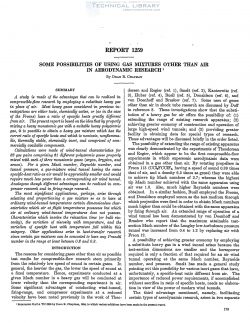naca-report-1259
- Version
- 157 Downloads
- 1.92 MB File Size
- 1 File Count
- November 2, 2016 Create Date
- November 2, 2016 Last Updated
National Advisory Committee for Aeronautics, Report - Some Possibilities of Using Gas Mixtures Other than Air in Aerodynamic Research

A study is made of the advantages that can be realized in
compressible-flow research by employing a substitute heavy gas
in place of air. Most heavy gases considered in previous in»
vestigations are either toxic, chemically active, or (as in the case
of the Freons) have a ratio of specific heats greatly difierent
from air. The present reportis based on the ideathat by properly
mixing a heavy monatomic gas with a suitable heavy polyatomic
gas, it is possible to obtain a heavy gas mixture which has the
correct ratio of specific heats and which is nontoxic, nonfiamm
ble, thermally stable, chemically inert, and comprised of com-
mercially available components.
Calculations were made of wind-tunnel characteristics for
63 gas pairs comprising 21 difl'erent polyatomic gases properly
mixed with each of three monatomic gases (argon, krypton, and
xenon). For a given Mach number, Reynolds number, and
tunnel pressure, a gas-mixture wind tunnel having the same
specific/heat ratio as air would be appreciably smaller and would
require much less power than a corresponding air wind tunnel.
Analogous though different advantages can be realized in com—
pressor research and in firing-range research.
The most significant applications, perhaps, arise through
selecting and proportioning a gas mixture so as to have at
ordinary wind-tunnel temperatures certain dimensionless char-
acteristics which air at flight temperatures possesses but which
air at ordinary wind-tunnel temperatures does not possess.
Characteristics which involve the relaxation time (or bulk vis-
cosity), the variation of viscosity with temperature, and the
variation of specific heat with temperature fall within this
category. Other applications arise in heat-transfer research
since certain gas mixtures can be concocted to have any Prandtl
number in the range at least between 02 and 0.8.
INTRODUCTION
The reasons for considering gases other than air as possible
test media for compressible-flow research stem primarily
from the relatively low speed of sound in certain gases. In
general, the heavier the gas, the lower the speed of sound at
a fixed temperature. Hence, experiments conducted at a
given Mach number in a heavy gas will be conducted at
lower velocity than the corresponding experiment in air.
Some significant advantages of conducting wind-tunnel,
firing-range, and compressor experiments at a reduced
velocity have been noted previously in the work of Theo—
dorsen and Regier (ref. 1), Smelt (ref. 2), Kantrowitz (ref.
3), Huber (ref. 4), Buell (ref. 5), Donaldson (ref. 6), and
von Doenhofi' and Braslow (ref. 7). Some uses of gases
other than air in shock tube research are discussed by Duff
in reference 8. These investigations show that the substi-
tution of a heavy gas'for air offers the possibility of: (1)
extending the range of existing research apparatus; (2)
achieving greater economy of construction and operation of
large high-speed wind tunnels; and (3) providing greater
facility in obtaining data for special types of research.
These advantages will be discussed briefly in the order listed.
| File | Action |
|---|---|
| naca-report-1259 Some Possibilities of Using Gas Mixtures Other than Air in Aerodynamic Research.pdf | Download |

Comment On This Post